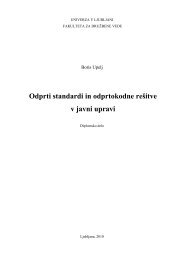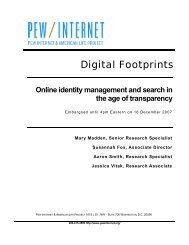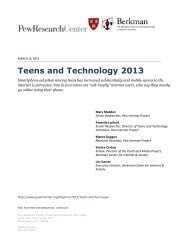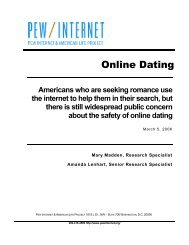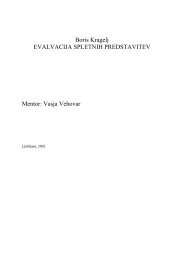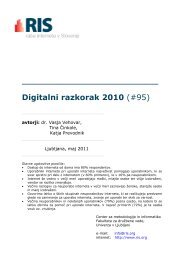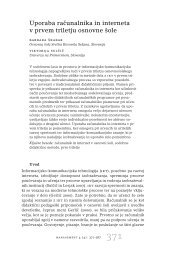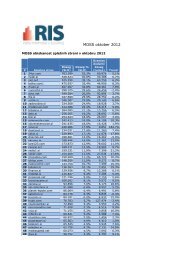the Labour Market Survey Report - Council of European ...
the Labour Market Survey Report - Council of European ...
the Labour Market Survey Report - Council of European ...
Create successful ePaper yourself
Turn your PDF publications into a flip-book with our unique Google optimized e-Paper software.
Recent policy responses to skill shortages in ICT in Ireland, Germany and <strong>the</strong> UK have included<br />
arrangements to accelerate work permit applications for overseas (beyond <strong>the</strong> EEA) applicants with<br />
ICT skills. France has been operating a simplified admission system for computer specialists since<br />
1998.<br />
Migration within <strong>the</strong> <strong>European</strong> Union has been increasing steadily over recent years, and is now <strong>of</strong><br />
growing significance to a number <strong>of</strong> Member State labour markets. Table 4 (from OECD Employment<br />
Outlook, 2001) shows <strong>the</strong> overall position <strong>of</strong> Intra-<strong>European</strong> mobility <strong>of</strong> EU citizens (for all occupations)<br />
in 1997, and gives a feel for <strong>the</strong> flows between countries. This migration is growing, and will undoubtedly<br />
continue to grow.<br />
OECD held a seminar in June 2001 on International Mobility <strong>of</strong> Highly Skilled Workers (“Human<br />
Resources in Science and Technology” (HRST)). The proceedings <strong>of</strong> <strong>the</strong> meeting, published early in<br />
2002 (OECD 2002), reported on <strong>the</strong> work. The seminar had three main objectives:<br />
• to provide data on <strong>the</strong> scale and characteristics <strong>of</strong> flows and stocks <strong>of</strong> skilled and highly skilled<br />
foreign workers in OECD Member countries and certain non-member countries, to assess <strong>the</strong><br />
quality <strong>of</strong> <strong>the</strong> available data and concepts used and to help improve <strong>the</strong>ir comparability;<br />
• to analyse <strong>the</strong> mobility <strong>of</strong> skilled workers and “HRST” and <strong>the</strong>ir impact on <strong>the</strong> economy through<br />
case studies covering most <strong>of</strong> <strong>the</strong> major regions that send and receive <strong>the</strong>se workers;<br />
• to examine appropriate migration policies for facilitating <strong>the</strong> mobility <strong>of</strong> skilled workers in ways<br />
that are beneficial both to “receiving” and “sending” countries.<br />
The studies showed that, while it is difficult to measure <strong>the</strong> international mobility <strong>of</strong> skilled workers,<br />
<strong>the</strong>re is every reason to believe that <strong>the</strong>se flows rose substantially during <strong>the</strong> 1990s. This being <strong>the</strong> case,<br />
mobility <strong>of</strong> “HRST” has a major impact on countries’ performance in <strong>the</strong> field <strong>of</strong> science and technology<br />
and <strong>the</strong>refore on growth. However, <strong>the</strong>se effects remain unequally distributed, especially between<br />
sending countries (mostly developing countries) and receiving countries. As a result, policies aimed at<br />
facilitating <strong>the</strong> recruitment and mobility <strong>of</strong> highly skilled workers, in particular migration policies, must<br />
endeavour to ensure a fairer distribution <strong>of</strong> benefits.<br />
Mobility between Member States – and different countries in general - in certain occupational areas<br />
(in particular in pr<strong>of</strong>essions which involve elements <strong>of</strong> safety risks for Society) is <strong>of</strong>ten constrained<br />
by <strong>the</strong> fact that certain governments regulate both <strong>the</strong> use <strong>of</strong> pr<strong>of</strong>essional “title” and in some cases,<br />
<strong>the</strong> practice <strong>of</strong> <strong>the</strong> pr<strong>of</strong>ession. Thus, for example, most countries regulate <strong>the</strong> practice <strong>of</strong> various<br />
medical pr<strong>of</strong>essions, and most countries regulate certain safety-related aspects <strong>of</strong> engineering (e.g.<br />
design <strong>of</strong> dams, aircraft, gas installations, etc.). This inevitably involves specific education, training and<br />
experience requirements that pose barriers to mobility for pr<strong>of</strong>essionals from o<strong>the</strong>r countries who have<br />
not “gone through that system”. The EU Commission has striven to tackle <strong>the</strong>se barriers, and <strong>the</strong>re exist<br />
certain Directives that require “receiving” Member States to minimize barriers to access to practice for<br />
experienced pr<strong>of</strong>essionals from o<strong>the</strong>r Member States, where <strong>the</strong>y have been practising in essentially<br />
<strong>the</strong> same area. The current set <strong>of</strong> Directives (some <strong>of</strong> which apply to specific pr<strong>of</strong>essions while some<br />
involve a “general systems” coverage <strong>of</strong> a range <strong>of</strong> o<strong>the</strong>rs), are currently undergoing review, and a new<br />
set <strong>of</strong> arrangements is expected to come into force within a year or so which will specify <strong>the</strong> migration<br />
processes for pr<strong>of</strong>essionals between Member States in a consistent way.<br />
IT Pr<strong>of</strong>essionals are generally not subject to <strong>the</strong>se barriers. This is probably because <strong>the</strong> IT pr<strong>of</strong>ession<br />
is relatively young, and <strong>the</strong>re has not been a history <strong>of</strong> regulation <strong>of</strong> practice that creates such barriers<br />
in <strong>the</strong> first place. However, in view <strong>of</strong> <strong>the</strong> increasing importance <strong>of</strong> IT systems to many (most) areas <strong>of</strong><br />
C E P I S I.T. PRACTITIONER SKILLS IN EUROPE | Section 4 | 69



